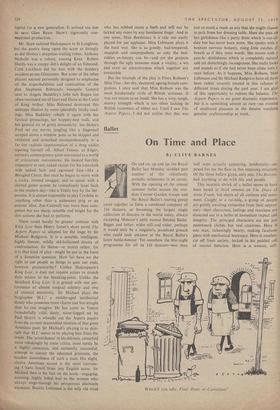Ballet
On Time and Place
By CLIVE BARNES
ON and on, up and up, the Royll Ballet last Monday skidded past another of the relentlessly periodic milestones in its career. With the opening of the annual summer ballet season the resi- dent Covent Garden troupe and the Royal Ballet's touring group came together to form a combined company of 116 dancers, so becoming the largest single collection of dancers in the world today, always excepting Moscow's aptly named Bolshoi Ballet. Bigger and better, wider still and wider, perhaps it would only be a singularly jaundiced grouch who could look askance at the Royal Ballet's latest battle-honour. Yet somehow the first-night programme for all its 116 dancers—less than half were actually appearing, incidentally—ex- posed for me the flaw in this imposing structure. Of the three ballets given, only one, The Burrow, had anything to do with life and people.
This neurotic shriek of a ballet seems to have been based at third remove on The Diary of Anne Frank, but shorn of all cosiness and senti- ment. Caught in a rat-hole, a group of people are grimly awaiting extinction from their oppres- sors—their characters, feelings and reactions are dissected out in a ballet of immediate impact and integrity. The principal characters are not just pasteboard cliches but real creations. Here is one man, sickeningly hearty, making facetious jokes with mechanical buoyancy. Here is another, cut off from society, locked in his padded cell of mental isolation. Here is a woman, self- 'Which'll you take, Fred: Doric or Corinthian?' dramatising her agony until its torment over- powers her. Here is a child who doesn't under- stand, and two adolescents who do. The theme, the Frank Martin music, Nicholas Georgiadis's oppressively dingy set and costumes, and most of all MacMillan's frantically eloquent chore- ography, come together to give us a ballet of our time and place.
But now look at the others. John Cranko's The Lady and the Fool is fairly expert hokum, Yet its paper-thin story of the transfiguring power of love is brought to its knees with sentimental archness and given the coup de grace by choreography that has more padding than stuffing. Massine's Mam'zelle Angot is a third- rate bullet boulle, only made bearable by Derain's ddcors and the burning vitality of Alexander Grant in its principal role. Both of these ballets are performed with that same kind of glossy polish you sometimes find in otherwise hollow American film epics. The ballets themselves remain poor examples of a poor kind.
Have I been unfair in analysing one ill- chosen programme? There are plenty of good works in the Royal Ballet's vaults, by Ashton, Howard, MacMillan and, for that matter, by Cranko and Massine. Yet the tendency is there, the tendency to lose touch with life. On and on, up and up-116 dancers today, perhaps, who knows, 216 dancers tomorrow. However, if we are to be given an overdose of The Lady and the Fool, Manezelle Angot, or even the cur- rently clumsily conceived versions of nineteenth- century classics, the point could be reached where the dancers outnumber the thinking audience.



































 Previous page
Previous page